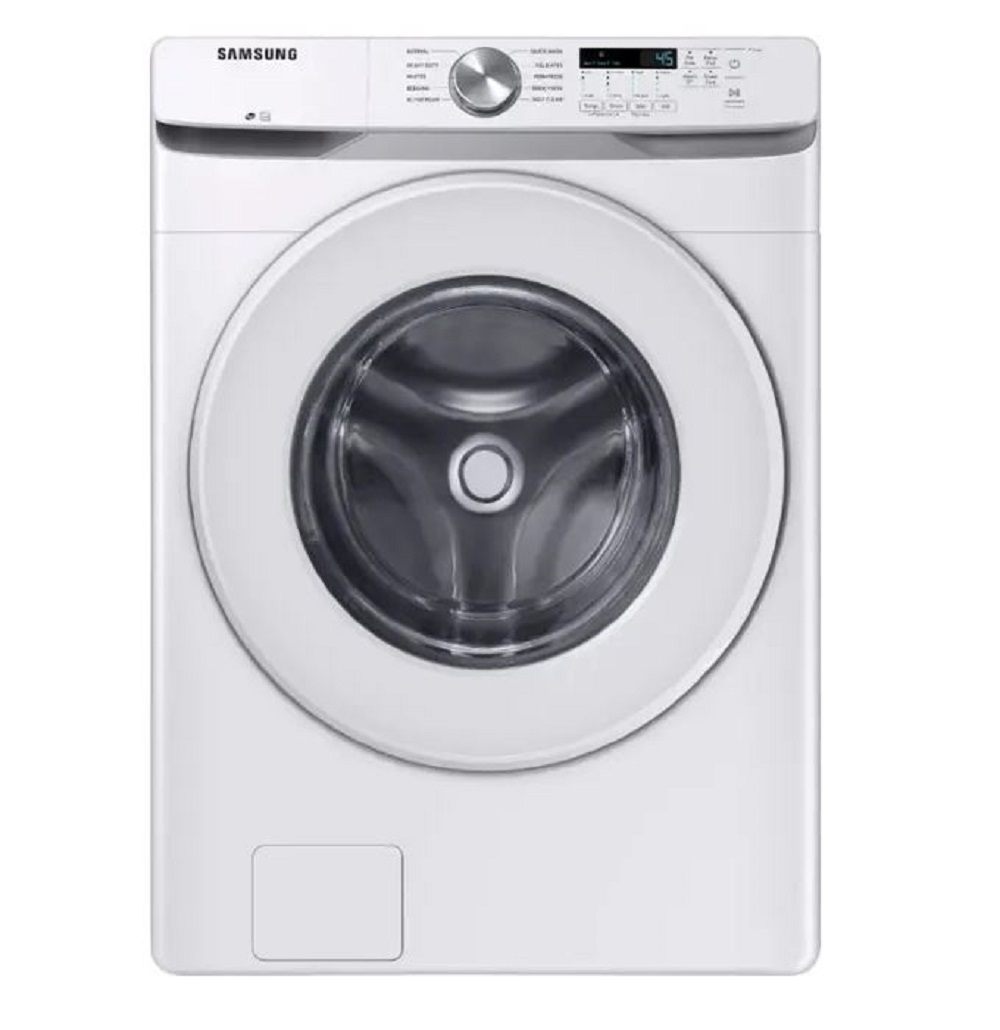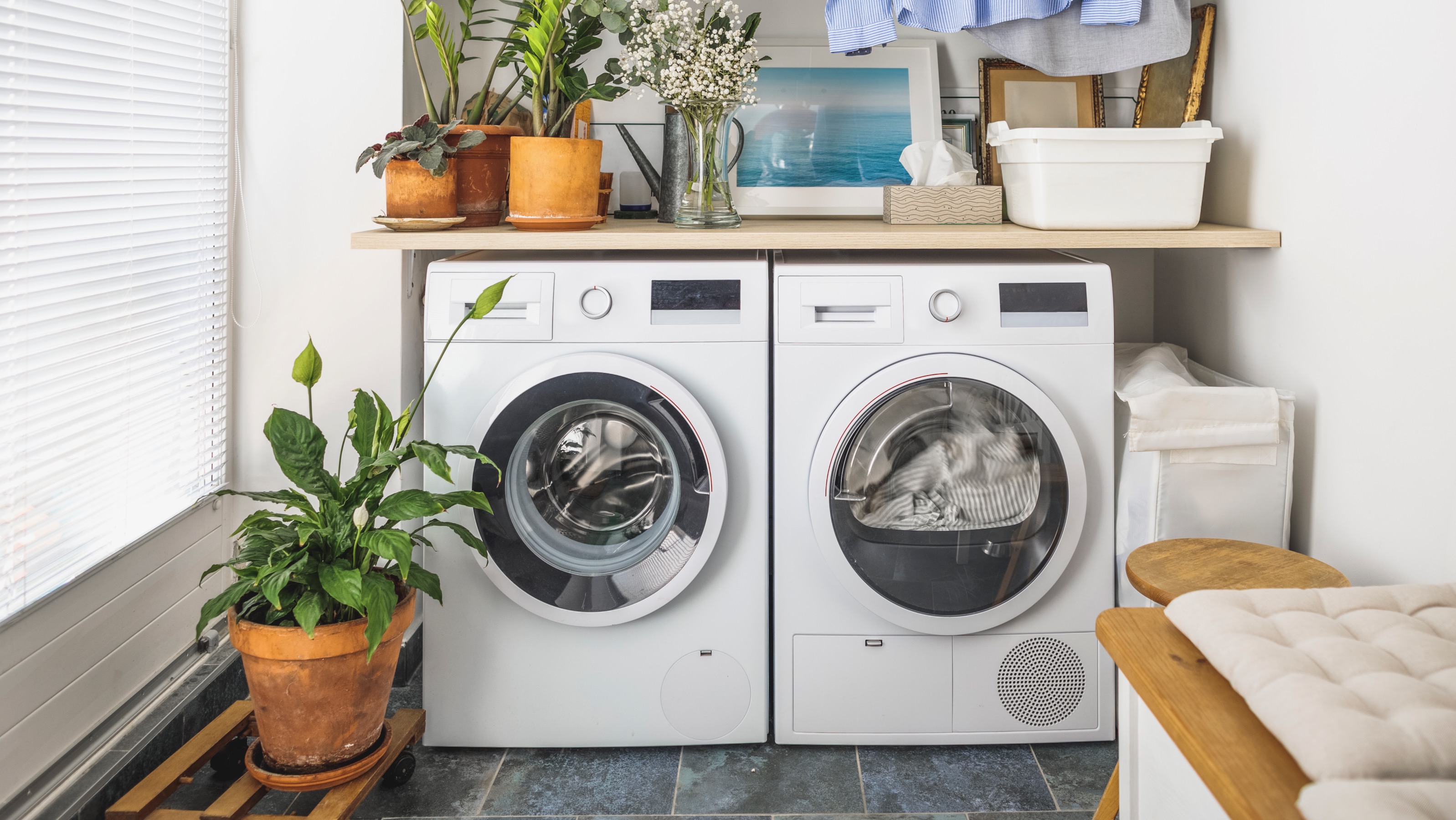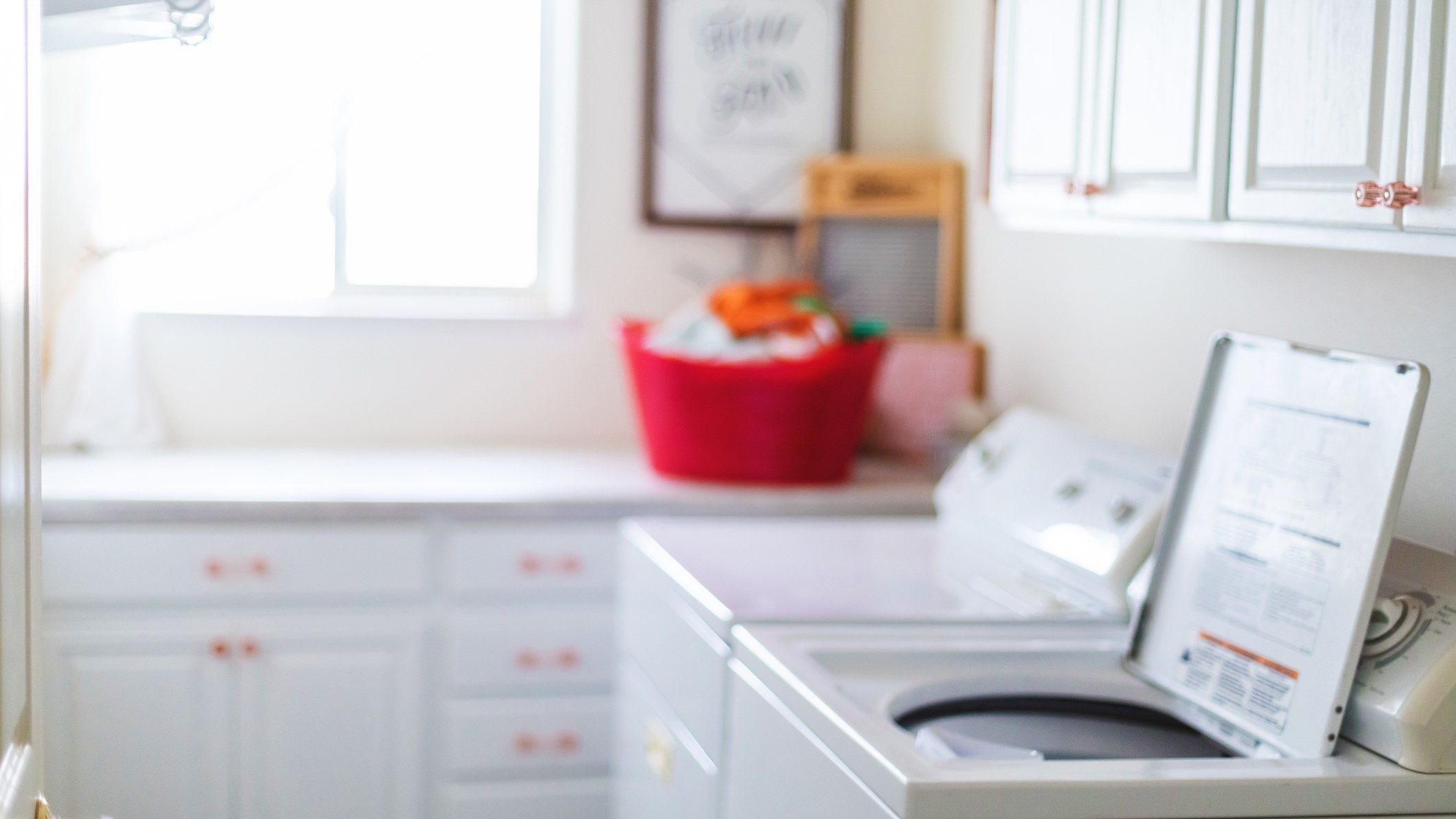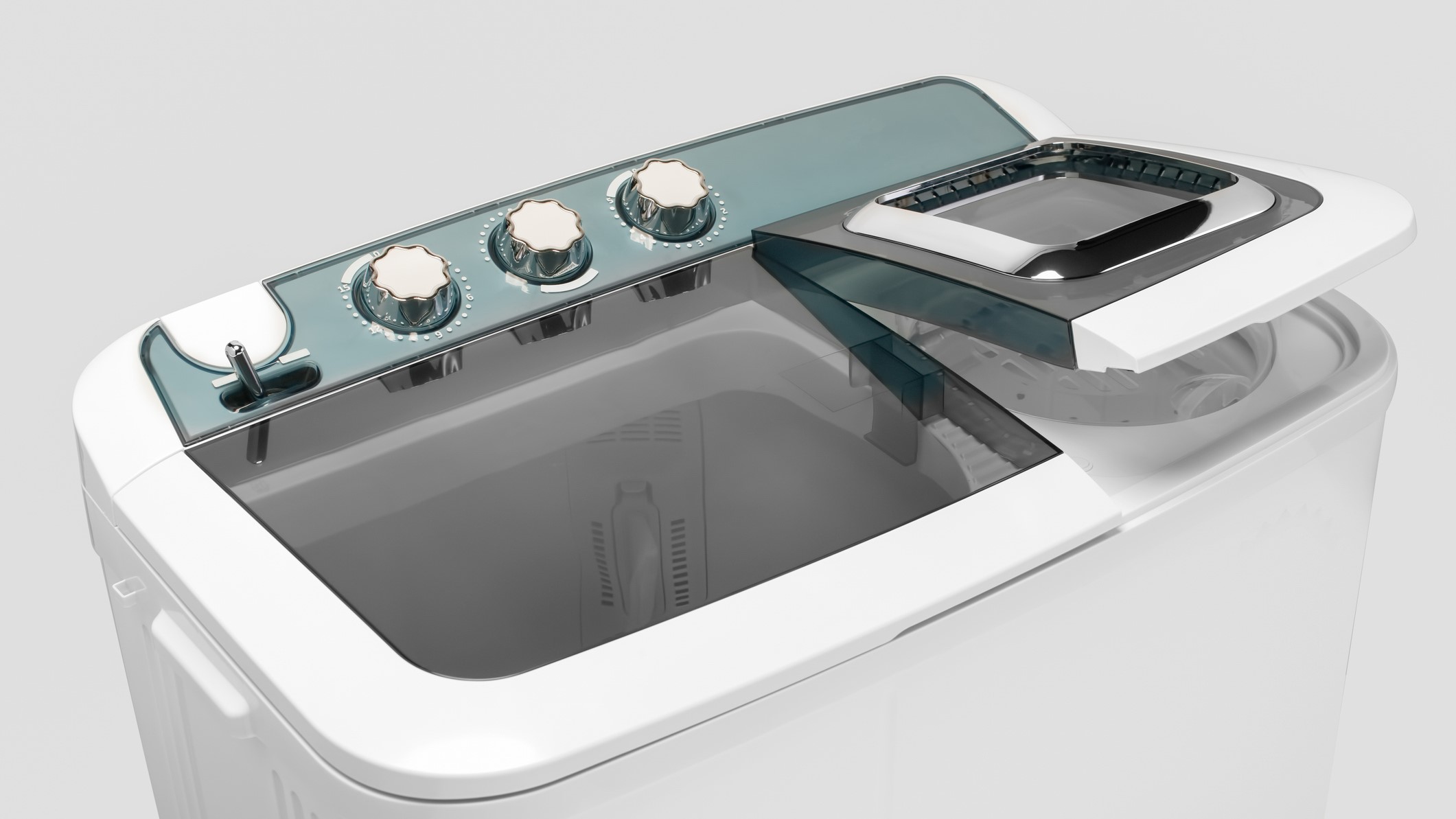Fully automatic vs semi-automatic washers: which is the better washing machine?
Each type of washer has pros and cons, but which one is right for your laundry needs?

Type: fully automatic
This portable compact washing machine only needs a small space to store, so it's a perfect solution for compact living.
It includes a see-through lid, electronic controls with an LED display, a stainless steel inner tub and two water pipes. The max weight capacity of this washing machine reaches 12 lbs., which is fine for doing medium-weight laundry. It also features a built-in drain pump and a drain pipe, for easy drainng of dirty water.
Pros
- Built-in drain pump
- Features a clear lid
- Equipped with water hose
Cons
- Deep tub is hard for shorter people to access
- Capacity may not be enough for some

Type: Semi-automatic
The Samsung WF42H5000AW is a no-frills washer with a large capacity and budget-friendly price that families will love.
Affordable and Energy Star certified, it has eight wash cycles, four spin speeds, and four different temperature settings. It also comes with a child lock, so children can’t accidentally start the washer when they’re out of the room.
One big pull of the Samsung WF42H5000AW is its VRT tech, which reduces vibration by balancing the drum, even at high speeds, to stop any noise created by fast spins or heavy loads.
Pros
- Wi-Fi connected
- Energy-efficient and ENERGY STAR Certified
- More compact size
- Stackable
Cons
- 4.5 capacity may not be enough for larger households
Choosing the best washing machine can feel like a bit of a puzzle. Should you go for the convenience of a fully automatic model or stick with the practicality of a semi-automatic one?
Both types of washers have their upsides and downsides, and it all comes down to what works best for your lifestyle and budget. Fully automatic machines tend to make laundry day a breeze with their high-tech features, but they can be pricier and may use more water and energy.
On the flip side, semi-automatic machines are lighter on the wallet and let you have more control over things like water usage, though they do require a bit more hands-on work.
In this article, I'll break down the pros and cons of each option - looking at factors like cost, features, capacity and more - to help you figure out which one is the perfect fit for your home. I'll also talk to leading laundry experts to get their input.
Fully automatic vs semi-automatic washers: Price
There's no doubt that semi-automatic washers are the more affordable option out of the two, so if you have a smaller budget, they could be a prudent choice. They also use less water overall and can operate without a continuous water supply, making them ideal for areas with water restrictions.
Front-load washers are more expensive upfront, but this is due to their increased washing capabilities and features.
"The fully automatic is pricier, of course," explains cleaning operations manager Elizabeth Shields. "You’ll get one of those for around $400 to $1,500 [like the 2.8 cu. ft. Capacity Portable Washer for $999 on Home Depot] while a semi-automatic will only set you back maybe $150 to $400 [like the Giantex Semi-automatic Washing Machine for $285.99 on Amazon)."
Sign up to receive the latest news, reviews, buying guides and deals direct to your inbox
Verdict: If budget is your main concern, a semi-automatic costs much less up front and is cheaper to run.
Elizabeth Shields is the Operations Manager at Super Cleaning Service Louisville, a professional cleaning company based in Louisville, Kentucky. Aside from being a manager, Elizabeth showcases her diverse expertise as an author of online articles. Her writing prowess spans across a wide array of subjects, from insightful parenting advice to enlightening pieces on home improvement, wellness, and the topic of sustainability.
Fully automatic vs semi-automatic washers: Design & features
When it comes to design and features, fully automatic and semi-automatic washers are pretty different in how they look and function.
Fully automatic washers are all about simplicity. They have just one drum that handles both washing and spinning. Once you throw your laundry in, the machine does all the work. Depending on your preference, fully automatic washers come in top-load or front-load designs and in a range of colors. They have a simple and sleek look, with digital controls and settings.
Fully automatic washers also come packed with features that make laundry a breeze, like multiple wash programs, temperature controls, automatic water level detection, and even smart connectivity on some models. You can usually just press a button, and the machine will handle everything from washing to rinsing and spinning, adjusting settings based on your load. Plus, many models have sensors that save water and energy by adapting to the weight of the clothes.
I spoke to laundry expert Ken Doty, to get his take on what features each type of washer offers. "Comparing features will lean heavily in favor of fully automatic washers," says Doty. "They have multiple wash settings for different types of fabrics, along with more advanced internal mechanisms for a more effective clean. Fully automatic washers can even come with smart features such as Wi-Fi connectivity."

Semi-automatic washers, on the other hand, are a bit more old-school or traditional in design. They often have two separate tubs - one for washing and one for spinning - so you’ll have to manually move your clothes from one tub to the other. Semi-automatics are usually top-load, and while they’re bulkier and take up more space, they’re easier to move around because they’re lighter than a fully automatic. You'll likely find fewer colourways available, though, and they don't have the same sleek look as a fully automatic washing machine.
Doty agrees (with me) that while semi-automatic washers will have everything that you need in a washer at a basic level, they do give you more control over how much water you use. Yes, they're more basic, but that's part of their charm. You won’t get as many fancy options, but they give you more control over the process. You get to decide when to move clothes from the wash tub to the spin tub, and how long each cycle runs. It’s more manual but perfect for people who prefer flexibility and don’t mind getting a bit more involved in their laundry routine.
Verdict: If you love tech and want a more modern look that doesn't take up too much space in your kitchen, utility or laundry room, fully automatic is the way to go. But if you don’t mind a traditional look and prefer something simple and budget-friendly, semi-automatic could be your style.

Ken Doty joined The Maids International in July 2013 as Vice President of Business Intelligence and was promoted to Chief Information Officer in February 2020. He is experienced in business intelligence with over 20 years of experience in consulting and information technology. He loves talking shop with other cleaning service professionals, and offering cleaning tips to anyone who asks!

Fully automatic vs semi-automatic washers: Size
When it comes to capacity, fully automatic washers tend to be more generous than semi-automatics. That's because they don't have an agitator in the drum, which can take up valuable space and aren't limited by the dual-tub design that semi-automatic washers have to deal with.
However, Shields says that it needn't be off-putting - it depends on your household needs.
"Semi-automatic are often smaller overall, so they're great if you’re working with a tighter laundry space or don't need to wash huge loads at once," says Shields. "But if you've got a family’s worth of laundry or just hate doing multiple loads, a fully automatic machine can tackle that mountain of clothes for you."
Here's a comparison of what you can expect to find in terms of capacity across both types of washers.
Fully automatic washers:
- Small to medium capacity: 1.5-3.5 cubic feet – works well for single households, couples or small families (2-3 people).
- Large capacity: 3.5-5.5 cubic feet or more – perfect for larger families (4+ people) who need to wash bigger loads of laundry.
Some models can go up to 7 cubic feet, making them ideal for bulkier items like comforters or curtains.
Semi-automatic washers:
- Small to medium capacity: 2-3 cubic feet – good for small households or people who don’t mind doing more frequent loads.
- Large capacity: 3-4 cubic feet – can handle larger loads, though semi-automatic machines may require more effort for bigger loads due to the manual work involved.
How large your household is and how often you do laundry are key factors in deciding the best washer capacity for your needs. If you're part of a smaller family or only do laundry occasionally, a smaller capacity washer will do the trick. But if you’ve got a big family and are constantly running loads throughout the week, you'll definitely want a larger machine that can handle bigger batches in one go. The right size ensures you're not wasting water and energy, while also making laundry day a lot easier.
Verdict: Fully automatic machines generally have a wider range, especially when it comes to larger capacities, while semi-automatic models tend to stay in the 2-4 cubic feet range, which may not be enough for a larger family or household.

Fully automatic vs semi-automatic washers: Verdict
Choosing between a fully automatic and a semi-automatic washing machine ultimately hinges on your individual situation. As Shields says, “This is quite a difficult question, but for me, it narrows down to your lifestyle and budget.”
A fully automatic machine might be your best bet if you lead a busy life with a full schedule. It saves you time and effort, allowing you to simply load it up, press a button, and walk away. Shields emphasizes, “I know convenience is key when you’re juggling a million things.”
However, budget plays a significant role, too. If you're keeping an eye on your expenses, a semi-automatic washer can be a fantastic option. As Shields points out, these machines are generally cheaper upfront and still get the job done without breaking the bank.
Doty adds, “My recommendation on which type of machine to use is dependent on one's personal situation. For modern households that are seeking convenient and effective cleaning, a fully automatic washing machine would be the path I would take.” But if you’re looking for a reliable washer that won’t strain your finances, the semi-automatic option will serve you well.
Now you've got everything you need. It's time to weigh these factors carefully to find the washing machine that fits your needs and lifestyle.

Joanne Lewsley is a reputable freelance writer specializing in evidence-based health and lifestyle content. With a background in journalism and extensive experience working for known brands, Joanne rigorously tests and evaluates home gadgets. Her passion for writing is complemented by her love for the outdoors and live music.
